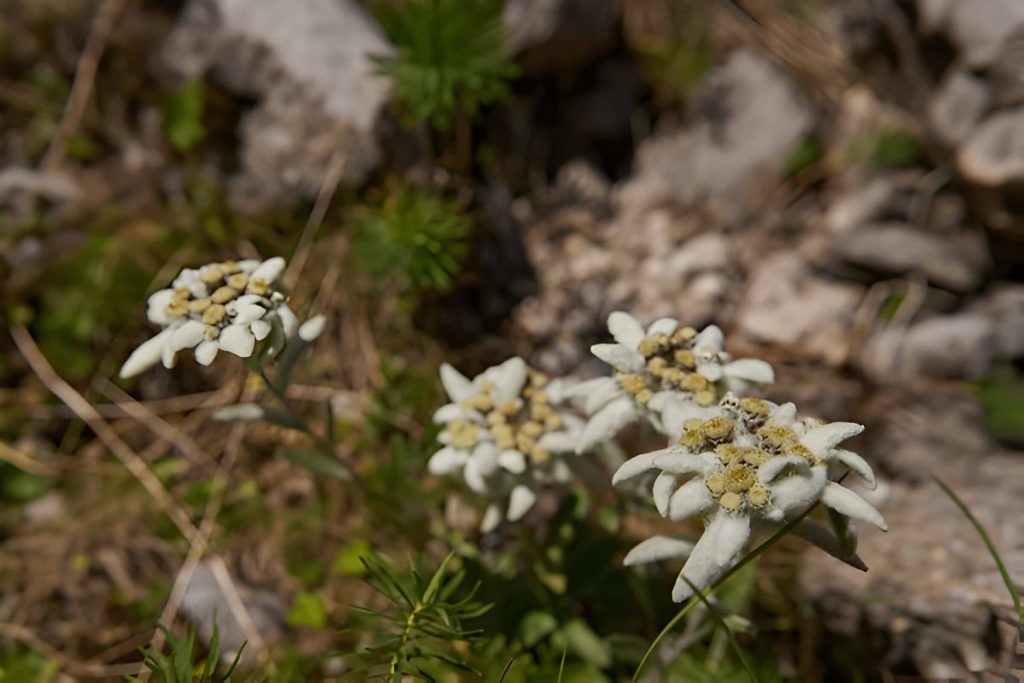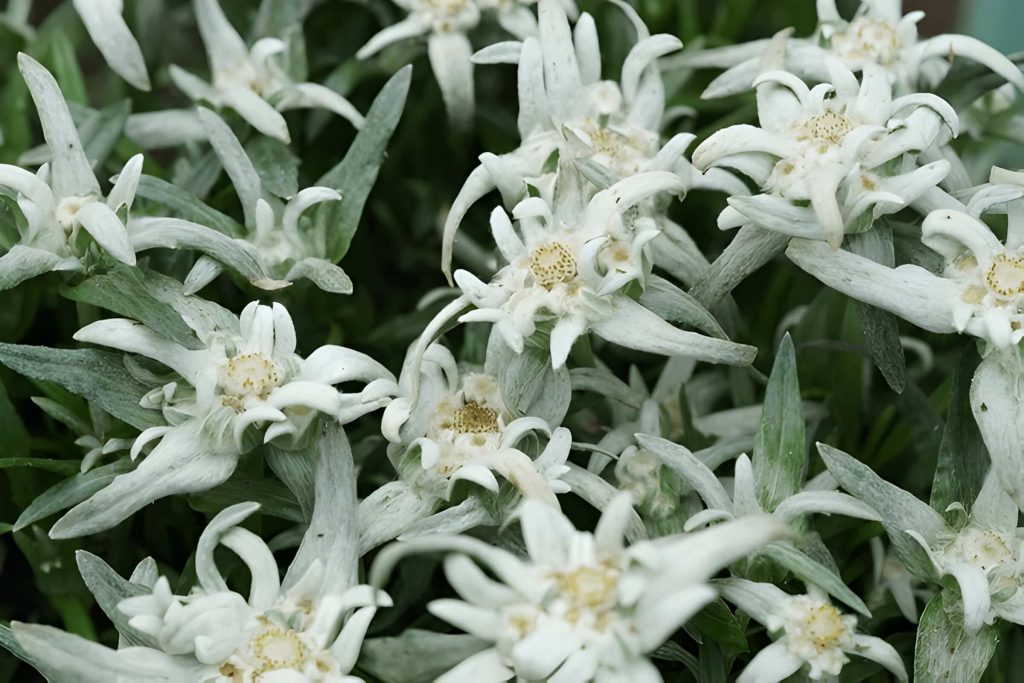
Edelweiss, scientifically known as Leontopodium nivale, is a captivating alpine flower belonging to the daisy family. This resilient plant thrives in the harsh, high-altitude conditions of rocky limestone terrains, typically found between 1,800 to 3,400 meters above sea level. Nature has equipped edelweiss flower with remarkable adaptations. Its leaves and flowers are adorned with a dense coat of fine hairs, a protective armor against the biting cold, aridity, and intense ultraviolet radiation prevalent in its mountainous habitat.
Beyond its striking appearance, edelweiss flower has earned a place in human culture and history. Its rarity, due to its specific ecological requirements and once-popular collection, has bestowed upon it an aura of mystique. A symbol of the untamed beauty of the Alps, it has been adopted as a national emblem by several European countries. With its delicate yet resilient nature, the edelweiss continues to inspire awe and admiration, a testament to the extraordinary adaptations of life in extreme environments. However The edelweiss flower carries rich symbolism, often representing strength, freedom, devotion, love, courage, and purity. Its name, “noble white,” reflects its perceived elegance and rarity. As an alpine flower, it embodies the spirit of the mountains, symbolizing wild beauty and resilience.
Edelweiss Care

Edelweiss, a captivating alpine flower, enchants with its silvery-white petals. Growing and caring for this unique plant requires specific conditions, but with the right approach, you can successfully cultivate this botanical treasure in your garden.
Light
Edelweiss thrives in bright, sunny locations. Abundant sunlight promotes robust growth and vibrant blooms. While dappled shade is tolerable, full sun exposure guarantees optimal development.
Soil
Well-draining soil is crucial for edelweiss. This alpine beauty prefers rocky, sandy, or gravelly substrates. Avoid heavy clay soils that retain moisture, as this can lead to root rot. Incorporating organic matter enhances soil fertility without compromising drainage.
Water
Edelweiss boasts remarkable drought tolerance. Once established, this plant requires minimal watering. Excessive moisture can harm the roots. During the initial growing period, provide occasional watering to encourage root development.
Temperature and Humidity

Edelweiss flourishes in cool, mountainous climates. It dislikes hot, humid conditions. Protect your edelweiss from excessive heat and ensure adequate airflow to prevent fungal diseases.
Fertilizer
Surprisingly, edelweiss prefers poor soil conditions. Avoid fertilizing as it can negatively impact growth and flowering. Excessive nutrients encourage lush foliage at the expense of blooms.
Pruning
Regular pruning is unnecessary for edelweiss. Remove spent flowers to maintain a tidy appearance and potentially encourage new blooms. However, extensive pruning is not required.
Propagating Edelweiss Flower
Edelweiss can be propagated through seeds or divisions. Seed germination requires specific conditions, including cold stratification. Division is a more reliable method for experienced gardeners. Dividing established edelweiss plants is a more reliable propagation method.
- Timing: Spring, after the last frost, is the ideal time for division.
- Preparation: Carefully dig up the edelweiss plant.
- Division: Gently separate the plant into smaller sections, ensuring each division has roots and shoots.
- Replanting: Plant the divisions in well-prepared soil with excellent drainage.
By following these steps and providing the right growing conditions, you can successfully propagate edelweiss and enjoy the beauty of these unique flowers in your garden.
How to Grow Edelweiss From Seed

Growing edelweiss from seed demands patience. Start by collecting mature seeds and stratifying them in the fridge for 3-4 weeks. Sow seeds in well-draining potting mix, ensuring light reaches them. Maintain consistent moisture and place in a cool, bright spot. Thin seedlings once they develop true leaves and gradually acclimate them to outdoor conditions before transplanting after the last frost. Choose a sunny location with well-drained soil and space seedlings about 8-12 inches apart.
Potting and Repotting Edelweiss
Edelweiss can be grown in containers, provided they have excellent drainage. Use a well-draining potting mix and choose a pot with drainage holes. Repotting is generally infrequent, as edelweiss prefers to be slightly root-bound.
Overwintering
Edelweiss possesses excellent cold hardiness. In regions with harsh winters, provide a protective layer of mulch to safeguard the plant from extreme frost.
Common Pests & Plant Diseases
Edelweiss is relatively resistant to pests and diseases. However, watch for aphids and slugs, which can occasionally infest the plant. Good air circulation helps prevent fungal issues.
By following these guidelines, you can successfully cultivate edelweiss and enjoy the enchanting beauty of this alpine gem in your garden.
How to Get Edelweiss to Bloom
Bloom Months and Duration
Edelweiss typically delights gardeners with its charming blooms during the summer months, specifically June and July. However, this alpine beauty sometimes surprises with early flowers as soon as May or extends its blooming period into September. While each individual flower graces the plant for about a week, the edelweiss consistently produces new blossoms, ensuring a captivating floral display throughout the season.
What Do Edelweiss Flowers Look and Smell Like?
Edelweiss flowers boast a unique and enchanting appearance. Their silvery-white petals form a star-like shape, and a soft, woolly texture covers them. While their looks captivate, edelweiss flowers do not possess a strong fragrance.
How to Encourage More Blooms
To encourage abundant edelweiss blooms, provide optimal growing conditions. This involves planting the edelweiss in a sunny location and ensuring the soil drains well. Interestingly, edelweiss thrives in poor soil, so avoid excessive fertilization. Regular removal of spent flowers stimulates the plant to produce new blooms.
Caring for Edelweiss After It Blooms
After the edelweiss finishes blooming, continue providing basic care. Maintain adequate watering, especially during dry spells. Light pruning helps maintain the plant’s shape. In regions with harsh winters, protect the edelweiss with a layer of mulch to safeguard it from frost.
Recommended Companion Plants

Edelweiss complements various alpine plants, creating stunning garden combinations. Consider planting edelweiss alongside:
Gentiana acaulis: This alpine gentian adds vibrant blue flowers.
Thymus serpyllum: Creeping thyme offers fragrant foliage and purple flowers.
Juniperus squamata ‘Blue Star’: This blue star juniper provides evergreen structure and color.
Calluna vulgaris: Common heather introduces beautiful autumnal hues.
Campanula poscharskyana: Adria bellflower offers cascading blue or purple blooms.
Scilla cretica: Star hyacinth adds early spring interest with its starry blue flowers.
Myosotis sylvatica: Wood forget-me-not creates a charming groundcover with delicate blue flowers.
FAQ: Edelweiss Flower
Can edelweiss grow in the United States?
Yes, edelweiss can grow in the United States. While it’s native to mountainous regions of Europe and Asia, it has adapted well to certain conditions in North America. It thrives in areas with cool climates and well-draining soil, making it suitable for rock gardens and alpine-like environments.
Why is edelweiss so rare?
Edelweiss gained its reputation for rarity due to its challenging growing conditions. It primarily thrives in high-altitude, mountainous regions with specific soil and climate requirements. Additionally, its delicate nature and historical over-picking for souvenirs contributed to its perceived scarcity. However, with cultivation efforts, edelweiss is becoming more accessible.
Is edelweiss invasive?
No, edelweiss is not considered an invasive species. It has specific growth requirements and doesn’t pose a threat to native ecosystems

I’ve always wanted to grow edelweiss! This is perfect!